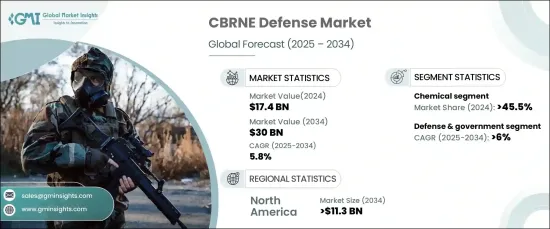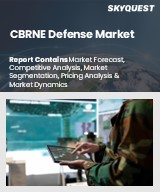
|
시장보고서
상품코드
1666626
세계의 CBRNE 방어 시장 기회, 성장 촉진요인, 산업 동향 분석 및 예측(2025-2034년)CBRNE Defense Market Opportunity, Growth Drivers, Industry Trend Analysis, and Forecast 2025 - 2034 |
||||||
세계 CBRNE 방어 시장은 2024년 174억 달러 규모에 달했고, 2025년부터 2034년까지 연평균 5.8% 성장할 것으로 예상됩니다.
이러한 확대의 배경에는 화학, 생물, 방사능, 핵무기, 폭발물(CBRNE) 사고의 위험 증가와 함께 비대칭 전쟁의 위협이 증가하고 있다는 점이 있습니다. 전 세계 정부와 조직들은 이러한 위험을 효과적으로 완화하기 위해 첨단 기술에 대한 투자를 우선순위로 삼고 있습니다. 자율 감지 시스템 및 착용형 보호 장비부터 첨단 오염 제거 솔루션에 이르기까지 의도적 및 우발적 CBRNE 사건에 대응하기 위한 다양한 혁신적 도구가 개발되고 있습니다.

또한, 인공지능(AI)과 사물인터넷(IoT)과 같은 첨단 기술을 CBRNE 방어 시스템에 도입함으로써 위협을 감지하고 대응하는 능력에 혁명이 일어나고 있습니다. 실시간 데이터 처리, 예측 분석, 상황 인식의 강화로 당국은 이제 위협을 보다 효율적으로 식별하고 무력화할 수 있게 되었습니다. 이러한 기술 혁신과 필요성의 결합은 시장의 강력한 성장 궤도에 힘을 실어주고 있습니다. 안보 도전의 성격이 끊임없이 진화하는 세계에서 CBRNE 방어 솔루션의 적극적인 대응과 지속적인 발전은 지역사회, 중요 인프라 및 국가 안보를 보호하는 데 필수적입니다.
| 시장 범위 | |
|---|---|
| 시작 연도 | 2024년 |
| 예측 연도 | 2025-2034년 |
| 시작 금액 | 174억 달러 |
| 예상 금액 | 300억 달러 |
| CAGR | 5.8% |
시장은 장비 유형별로 구분되며, 화학, 생물, 방사능, 핵, 폭발물 방어 솔루션이 중요한 역할을 하며, 2024년에는 화학 방어 분야가 45.5%의 점유율을 차지하며 시장을 주도할 것으로 예상됩니다. 이 부문의 우위는 독성 산업용 화학물질과 화학무기 물질을 신속하게 식별할 수 있는 휴대용 기기 및 휴대용 센서와 같은 감지 기술의 혁신에 기인합니다. 이러한 도구는 군과 민간 팀이 신속하고 효과적인 대응을 할 수 있게 해줍니다. 또한, 화학물질 위협이 빈번하게 발생함에 따라 고급 개인보호장비(PPE)와 오염제거 시스템에 대한 수요가 증가하면서 이 분야의 성장에 박차를 가하고 있습니다.
CBRNE 방어 시장의 최종 사용자 범주에는 국방 및 정부 부문, 국토 안보 부문, 민간 및 상업 부문이 포함됩니다. 국방 및 정부 부문은 2034년까지 연평균 복합 성장률(CAGR) 6%로 성장할 것으로 예상됩니다. 각국 정부는 CBRNE 방어를 강화하기 위한 노력을 강화하고 있으며, 그 결과 군사 작전을 위한 감지 도구, 보호 장비, 오염 제거 솔루션에 대한 지출이 증가하고 있습니다. 지정학적 긴장이 고조되고 CBRNE 무기 배치의 위협은 이 분야에 대한 투자를 더욱 가속화시키고 있습니다.
북미의 CBRNE 방어 시장은 2034년까지 113억 달러에 달할 것으로 예상됩니다. 이 지역은 첨단 기술 활용의 최전선에 있으며, 드론과 로봇과 같은 자율 시스템은 이제 감지 및 대응 활동에 필수적인 요소로 자리 잡고 있습니다. 이러한 기술 혁신은 효율성과 안전성을 높이고 위험한 환경에서 CBRNE 위험을 효과적으로 줄일 수 있습니다.
목차
제1장 조사 방법과 조사 범위
- 시장 범위와 정의
- 기본 추정과 계산
- 예측 계산
- 데이터 소스
- 1차 데이터
- 2차 데이터
- 유료 정보원
- 공적 정보원
제2장 주요 요약
제3장 업계 인사이트
- 생태계 분석
- 밸류체인에 영향을 미치는 요인
- 이익률 분석
- 파괴
- 향후 전망
- 제조업체
- 유통업체
- 공급업체 상황
- 이익률 분석
- 주요 뉴스
- 규제 상황
- 영향요인
- 성장 촉진요인
- 업계의 잠재적 리스크&과제
- 성장 가능성 분석
- Porter의 Five Forces 분석
- PESTEL 분석
제4장 경쟁 구도
- 서론
- 기업 점유율 분석
- 경쟁 포지셔닝 매트릭스
- 전략 전망 매트릭스
제5장 시장 추산·예측 : 유형별, 2021년-2034년
- 주요 동향
- 화학제품
- 생물학적 물질
- 방사선
- 핵물질
- 폭발물
제6장 시장 추산·예측 : 기기별, 2021년-2034년
- 주요 동향
- 방호 웨어러블
- 방호복
- 방독 마스크 및 후드
- 탈출 장비 및 후드
- 보호화
- 보호 장갑
- 호흡기
- 자급식 호흡 장비(SCBA)
- 동력식 공기 청정 호흡기(PAPR)
- 감지 및 모니터링 시스템
- 열화상 카메라
- 센서
- 고정형 및 이동형 모니터링 장치
- 샘플링 장비
- 선별 검사 키트
- 적외선 분광기
- 비콘
- 스탠드 오프 검출기
- 가스 감지기
- 생물학적 위협 감지기
- 방사선 위협 감지기
- 오염 제거 시스템
- 오염 인디케이터 제염 보증 시스템(CIDAS)
- 스프레이 유닛
- 기타
- 시뮬레이터
제7장 시장 추산·예측 : 최종사용자별, 2021년-2034년
- 주요 동향
- 방위 및 정부
- 군
- 공군
- 육군
- 해군
- 군
- 국토안보
- 경찰
- 소방
- 민간 및 상업
제8장 시장 추산·예측 : 지역별, 2021년-2034년
- 주요 동향
- 북미
- 미국
- 캐나다
- 유럽
- 영국
- 독일
- 프랑스
- 이탈리아
- 스페인
- 러시아
- 아시아태평양
- 중국
- 인도
- 일본
- 한국
- 호주
- 라틴아메리카
- 브라질
- 멕시코
- 중동 및 아프리카
- 남아프리카공화국
- 사우디아라비아
- 아랍에미리트(UAE)
제9장 기업 개요
- Argon Electronics
- Avon Protection
- Battelle
- Bruker
- Chemring Group
- INDRA
- Karcher Futuretech
- KNDS
- Leidos
- Rheinmetall
- Saab
- Smiths Group
- Teledyne FLIR
- Thales
The Global CBRNE Defense Market, with its valuation reaching USD 17.4 billion in 2024, is projected to grow at a CAGR of 5.8% from 2025 to 2034. This expansion is fueled by the escalating threat of asymmetric warfare, combined with an increasing risk of chemical, biological, radiological, nuclear, and explosive (CBRNE) incidents. Governments and organizations worldwide are prioritizing investments in state-of-the-art technologies to mitigate these risks effectively. From autonomous detection systems and wearable protective gear to advanced decontamination solutions, a wide array of innovative tools is being developed to address both intentional and accidental CBRNE events.

Additionally, the incorporation of cutting-edge technologies such as artificial intelligence (AI) and the Internet of Things (IoT) into CBRNE defense systems has revolutionized threat detection and response capabilities. Real-time data processing, predictive analytics, and enhanced situational awareness now enable authorities to identify and neutralize threats more efficiently. This convergence of innovation and necessity is driving the market's robust growth trajectory. In a world where the nature of security challenges is constantly evolving, proactive measures and continuous advancements in CBRNE defense solutions have become indispensable for safeguarding communities, critical infrastructure, and national security.
| Market Scope | |
|---|---|
| Start Year | 2024 |
| Forecast Year | 2025-2034 |
| Start Value | $17.4 Billion |
| Forecast Value | $30 Billion |
| CAGR | 5.8% |
The market is segmented by equipment type, with chemical, biological, radiological, nuclear, and explosive defense solutions playing a critical role. In 2024, the chemical defense segment dominated the market, commanding 45.5% of the share. This segment's prominence is attributed to ongoing innovations in detection technologies, including portable sensors and handheld devices that can rapidly identify toxic industrial chemicals and chemical warfare agents. These tools enable swift and effective responses from military and civilian teams alike. Furthermore, the growing frequency of chemical threats has heightened the demand for advanced personal protective equipment (PPE) and decontamination systems, fueling the segment's expansion.
End-user categories for the CBRNE defense market include defense and government, homeland security, and civil and commercial sectors. The defense and government sector is expected to grow at a CAGR of 6% through 2034. Global governments are intensifying their efforts to fortify CBRNE defenses, resulting in increased spending on detection tools, protective equipment, and decontamination solutions for military operations. Rising geopolitical tensions and the looming threat of CBRNE weapon deployment further accelerate investments in this sector.
In North America, the CBRNE defense market is poised to generate USD 11.3 billion by 2034. The region is at the forefront of leveraging advanced technologies, with autonomous systems like drones and robots now integral to detection and response operations. These innovations enhance efficiency and safety, enabling effective mitigation of CBRNE risks in hazardous environments.
Table of Contents
Chapter 1 Methodology & Scope
- 1.1 Market scope & definitions
- 1.2 Base estimates & calculations
- 1.3 Forecast calculations
- 1.4 Data sources
- 1.4.1 Primary
- 1.4.2 Secondary
- 1.4.2.1 Paid sources
- 1.4.2.2 Public sources
Chapter 2 Executive Summary
- 2.1 Industry synopsis, 2021-2034
Chapter 3 Industry Insights
- 3.1 Industry ecosystem analysis
- 3.1.1 Factor affecting the value chain
- 3.1.2 Profit margin analysis
- 3.1.3 Disruptions
- 3.1.4 Future outlook
- 3.1.5 Manufacturers
- 3.1.6 Distributors
- 3.2 Supplier landscape
- 3.3 Profit margin analysis
- 3.4 Key news & initiatives
- 3.5 Regulatory landscape
- 3.6 Impact forces
- 3.6.1 Growth drivers
- 3.6.1.1 Rising geopolitical tensions and security threats
- 3.6.1.2 Growing cooperation between military and civilian sectors for integrated CBRNE defense
- 3.6.1.3 Government investments in defense and homeland security
- 3.6.1.4 Increasing focus on readiness and training programs
- 3.6.1.5 Rising integration of unmanned systems, drones, and robotics for remote CBRNE detection
- 3.6.2 Industry pitfalls & challenges
- 3.6.2.1 High costs of advanced technology development and deployment
- 3.6.2.2 Integration and interoperability issues
- 3.6.1 Growth drivers
- 3.7 Growth potential analysis
- 3.8 Porter’s analysis
- 3.9 PESTEL analysis
Chapter 4 Competitive Landscape, 2024
- 4.1 Introduction
- 4.2 Company market share analysis
- 4.3 Competitive positioning matrix
- 4.4 Strategic outlook matrix
Chapter 5 Market Estimates & Forecast, By Type, 2021-2034 (USD Million)
- 5.1 Key trends
- 5.2 Chemical
- 5.3 Biological
- 5.4 Radiological
- 5.5 Nuclear
- 5.6 Explosive
Chapter 6 Market Estimates & Forecast, By Equipment, 2021-2034 (USD Million)
- 6.1 Key trends
- 6.2 Protective wearables
- 6.2.1 Protective clothing
- 6.2.2 Protective gas mask and hoods
- 6.2.3 Escape devices/hoods
- 6.2.4 Protective shoes
- 6.2.5 Protective gloves
- 6.3 Respiratory systems
- 6.3.1 Self-contained breathing apparatus (SCBA)
- 6.3.2 Powered Air Purifying Respirator (PAPR)
- 6.4 Detection & monitoring systems
- 6.4.1 Thermal imagers
- 6.4.2 Sensors
- 6.4.3 Stationary and mobile monitoring devices
- 6.4.4 Sampling equipment
- 6.4.5 Screening test kit
- 6.4.6 Infrared spectroscopy
- 6.4.7 Beacon
- 6.4.8 Stand-off detectors
- 6.4.9 Gas detectors
- 6.4.10 Biological threat detectors
- 6.4.11 Radiological threat detectors
- 6.5 Decontamination systems
- 6.5.1 Contamination Indicator Decontamination Assurance Systems (CIDAS)
- 6.5.2 Spray unit
- 6.5.3 Others
- 6.6 Simulators
Chapter 7 Market Estimates & Forecast, By End-user, 2021-2034 (USD Million)
- 7.1 Key trends
- 7.2 Defense & government
- 7.2.1 Armed forces
- 7.2.1.1 Air force
- 7.2.1.2 Army
- 7.2.1.3 Navy
- 7.2.1 Armed forces
- 7.3 Homeland security
- 7.3.1 Police
- 7.3.2 Fire safety department
- 7.4 Civil & commercial
Chapter 8 Market Estimates & Forecast, By Region, 2021-2034 (USD Million)
- 8.1 Key trends
- 8.2 North America
- 8.2.1 U.S.
- 8.2.2 Canada
- 8.3 Europe
- 8.3.1 UK
- 8.3.2 Germany
- 8.3.3 France
- 8.3.4 Italy
- 8.3.5 Spain
- 8.3.6 Russia
- 8.4 Asia Pacific
- 8.4.1 China
- 8.4.2 India
- 8.4.3 Japan
- 8.4.4 South Korea
- 8.4.5 Australia
- 8.5 Latin America
- 8.5.1 Brazil
- 8.5.2 Mexico
- 8.6 MEA
- 8.6.1 South Africa
- 8.6.2 Saudi Arabia
- 8.6.3 UAE
Chapter 9 Company Profiles
- 9.1 Argon Electronics
- 9.2 Avon Protection
- 9.3 Battelle
- 9.4 Bruker
- 9.5 Chemring Group
- 9.6 INDRA
- 9.7 Karcher Futuretech
- 9.8 KNDS
- 9.9 Leidos
- 9.10 Rheinmetall
- 9.11 Saab
- 9.12 Smiths Group
- 9.13 Teledyne FLIR
- 9.14 Thales



















